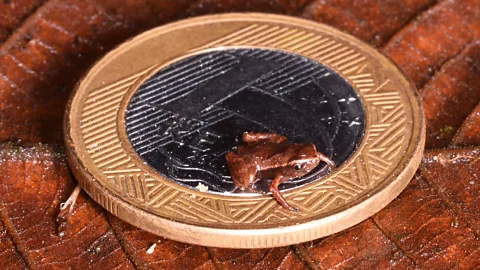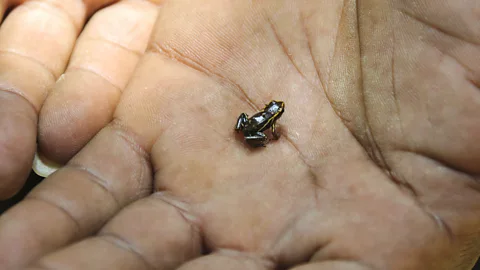See the world's tiniest frogs - and why being so small is so hard
 Renato Gaiga
Renato GaigaBrachycephalus pulex might be the title holders for world's smallest vertebrate. But it's not easy being green – or tiny.
Scientists believe they may know what the world's smallest vertebrate is. A tiny, pea-sized Brazilian frog called Brachycephalus pulex (or, Brazilian flea toad, even though it is a frog) has the tiniest measurements, according to new research.
Back in 2011, Mirco Solé, a researcher at the State University of Santa Cruz in Brazil, was the first to investigate this species' size compared to that of other similar frogs. The sample wasn't large enough at the time to be conclusive, but the most recent research, in which Solé and his team measured the body lengths of 46 flea toads and confirmed the frogs’ maturity and sex by examining their gonads and checking for the presence of vocal slits in their throats (which only males have), was more expansive. It found that male B. pulex frogs measured in at just over 7mm (.28in). Females were slightly larger at just over 8mm (.31in).
Mark D. Scherz, curator of Herpetology at the Natural History Museum of Denmark, says that this species of "impressively small" frogs is very likely the title holder for tiniest vertebrate in the world, and that the assertion "is backed up with a remarkably large dataset". Still, he maintains that while there is a lot of current evidence, it's not possible to know what lies ahead in terms of new discoveries. "It’s definitely possible for the envelope to keep getting pushed," he says.
 Getty Images
Getty ImagesThat has been the pattern, after all. The record has continuously evolved, going to smaller and smaller species as more research has been done. "In the last 30 years," Scherz notes, "the record has gone from around 10mm (0.39in) (Eleutherodactylus iberia) to 6.45 (.25in) - 8.87mm (0.35in)" which is a more than 10% reduction in length.
Sherz says that although there are likely to be more tiny contenders for the smallest vertebrate title in coming years, that "small" depends on how the species is being measured. "If we take it as a linear measure, the frogs are currently clear winners," he explains. "But if we go by mass or volume, then fish would likely claim the title, as they are very narrow-bodied and slender, whereas the frogs are rather round." He imagines there are some tiny "planktonic fishes" that have not yet been discovered.
Those discoveries, and subsequent research to understand what makes these species unique and interesting besides their size, have their challenges when it comes to the smallest species, which is why pea-sized frogs are tracked in some unique ways. Some scientists have even introduced tiny tracking pants and other mini belt-like devices that the miniature vertebrates wear for a short time to help scientists better understand the way they move.
 Mark D. Scherz
Mark D. ScherzLuci Kirkpatrick, a lecturer at the School of Environmental and Natural Sciences at Bangor University in North Wales, understands some of those challenges. She developed tracking devices that fit some smaller animals. She says they are traditionally tough to track, but that doing so is massively important for conservation. While small animals are tiny, they're abundant "ecosystem engineers" who she says are "critical in making sure the food web functions properly".
As the tiniest vertebrates around, B. pulex frogs face their own difficulties – in addition to being difficult to monitor accurately. They struggle to do something frogs are supposed to be inherently good at: jumping. In fact, 2022 research found that these miniature vertebrates actually lose their balance when they leave the ground. They're simply so tiny that they can't make proper use of their vestibular systems, which help control stabilisation.
These frogs may be small, and they may not always land on their feet, but experts say we should still keep tabs on what the tiniest creatures are doing. "Those populations can change quickly and respond to changes in the environment," which can be hugely positive, she explains. But a disease outbreak among the population could be catastrophic if not monitored, she says.
"If you want to conserve an animal, you need to know what it's doing," for better or for worse, Kirkpatrick explains.
--
If you liked this story, sign up for The Essential List newsletter – a handpicked selection of features, videos and can't-miss news delivered to your inbox every Friday.
